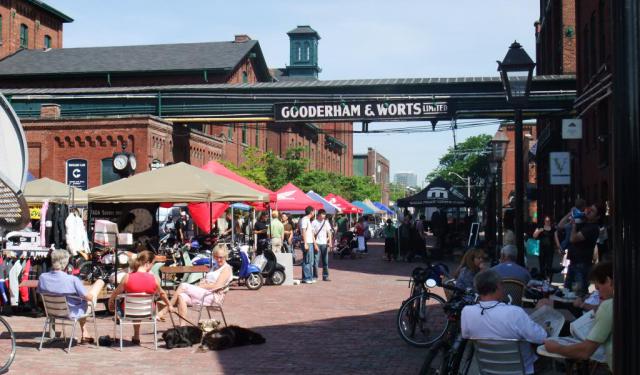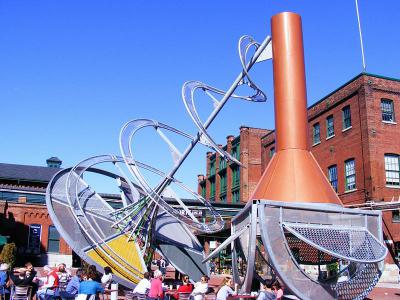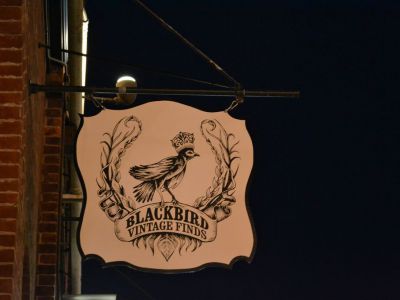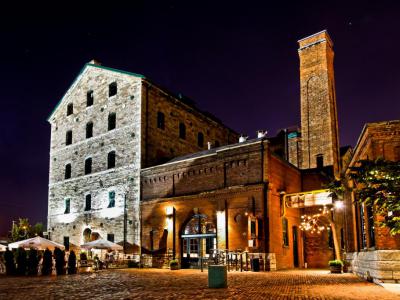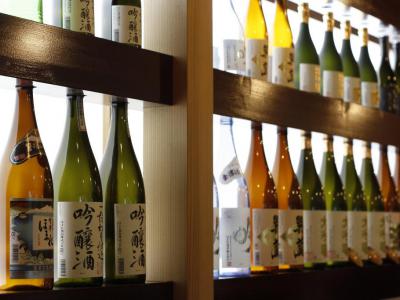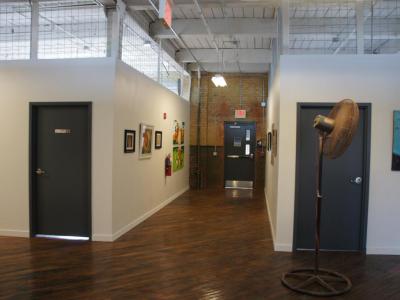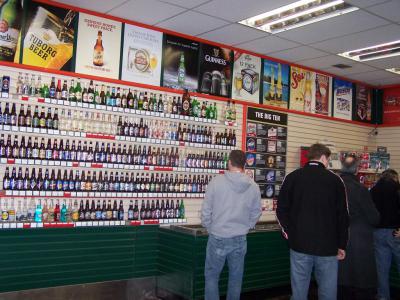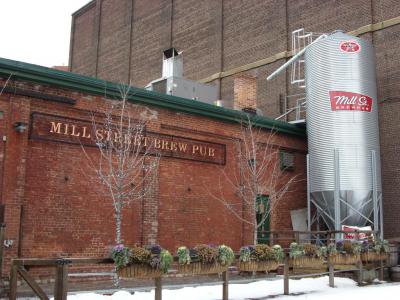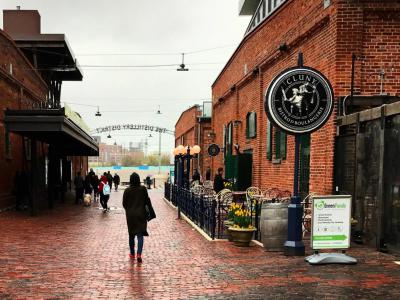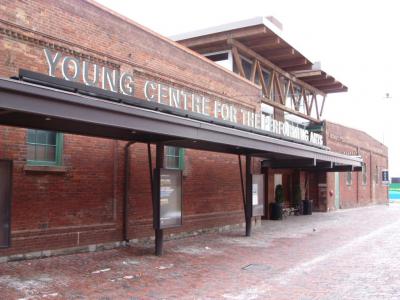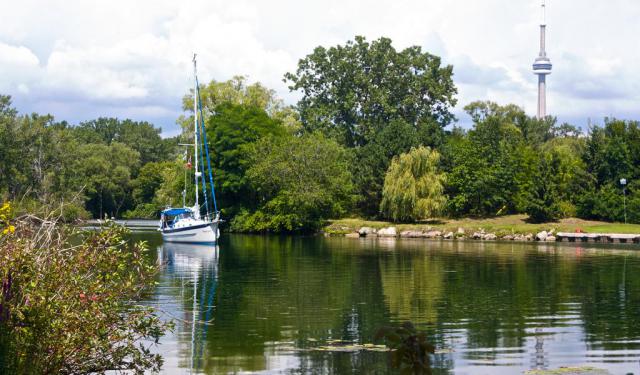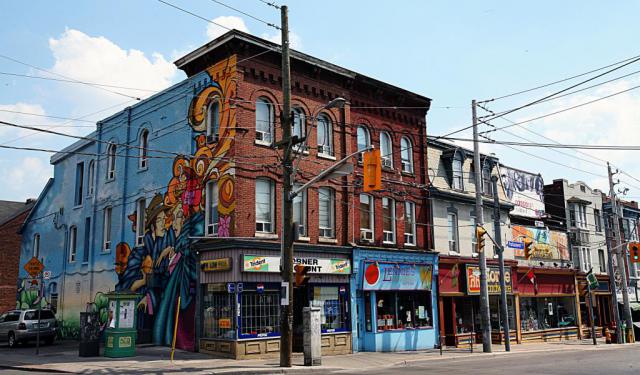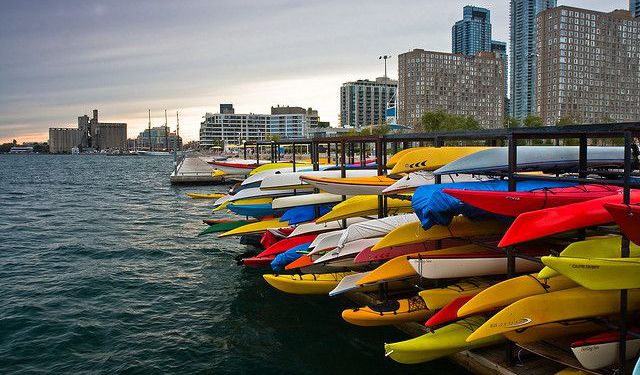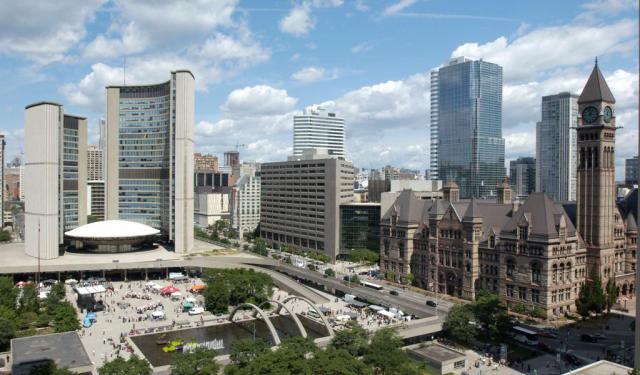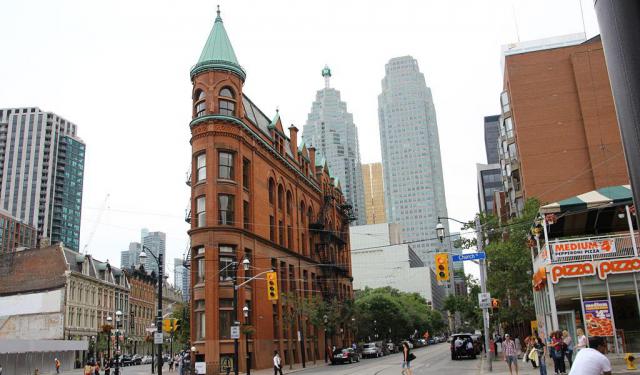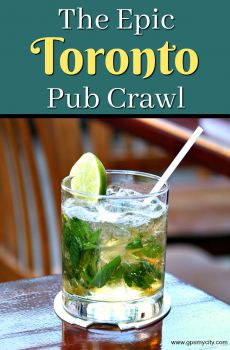Distillery District Walking Tour (Self Guided), Toronto
Toronto's Distillery District is a trendy neighborhood and an architectural treasure dating back to 1859. Once the largest distillery in the British Empire, today this former industrial complex is a National Historic Site of Canada and a unique pocket of Victorian-era architecture, featuring the continent's best-preserved collection of cobblestone pathways and historic buildings housing restaurants, boutiques, and art galleries.
Centered around Trinity Street, this area has undergone a drastic transformation into a pedestrian-only hub for forward-thinking art and design. One of its standout features is the Artscape Distillery Studios, providing artists with unique spaces to create and showcase their work. Nearby, Blackbird Vintage Finds offers a treasure trove of vintage and antique items, perfect for collectors and enthusiasts.
There are still a few spaces in the Distillery District carrying on the tradition of alcohol making, whose products you can try. One such is the Stone Distillery, a stunning heritage building that houses various businesses, including the Ontario Spring Water Sake Company, where you can sample traditional Japanese sake. Also, for those interested in craft beer, the Beer Store and Mill Street Brewery are must-visit spots, offering a wide selection of local brews.
Art enthusiasts can explore the Arta Gallery and Corkin Gallery, both showcasing a diverse range of contemporary artworks.
When it's time to dine, Cluny Bistro offers a French-inspired menu in a charming setting.
The Distillery District is also home to the Young Centre for the Performing Arts, where you can catch exciting theater productions and performances.
Ultimately, Toronto's Distillery District is a lively destination that brings together history, art, shopping, dining, and entertainment in a rather creative way. To explore its romantically European cobblestone streets and have a good time, follow this self-guided walk!
Centered around Trinity Street, this area has undergone a drastic transformation into a pedestrian-only hub for forward-thinking art and design. One of its standout features is the Artscape Distillery Studios, providing artists with unique spaces to create and showcase their work. Nearby, Blackbird Vintage Finds offers a treasure trove of vintage and antique items, perfect for collectors and enthusiasts.
There are still a few spaces in the Distillery District carrying on the tradition of alcohol making, whose products you can try. One such is the Stone Distillery, a stunning heritage building that houses various businesses, including the Ontario Spring Water Sake Company, where you can sample traditional Japanese sake. Also, for those interested in craft beer, the Beer Store and Mill Street Brewery are must-visit spots, offering a wide selection of local brews.
Art enthusiasts can explore the Arta Gallery and Corkin Gallery, both showcasing a diverse range of contemporary artworks.
When it's time to dine, Cluny Bistro offers a French-inspired menu in a charming setting.
The Distillery District is also home to the Young Centre for the Performing Arts, where you can catch exciting theater productions and performances.
Ultimately, Toronto's Distillery District is a lively destination that brings together history, art, shopping, dining, and entertainment in a rather creative way. To explore its romantically European cobblestone streets and have a good time, follow this self-guided walk!
How it works: Download the app "GPSmyCity: Walks in 1K+ Cities" from Apple App Store or Google Play Store to your mobile phone or tablet. The app turns your mobile device into a personal tour guide and its built-in GPS navigation functions guide you from one tour stop to next. The app works offline, so no data plan is needed when traveling abroad.
Distillery District Walking Tour Map
Guide Name: Distillery District Walking Tour
Guide Location: Canada » Toronto (See other walking tours in Toronto)
Guide Type: Self-guided Walking Tour (Sightseeing)
# of Attractions: 10
Tour Duration: 1 Hour(s)
Travel Distance: 0.8 Km or 0.5 Miles
Author: DanaOffice
Sight(s) Featured in This Guide:
Guide Location: Canada » Toronto (See other walking tours in Toronto)
Guide Type: Self-guided Walking Tour (Sightseeing)
# of Attractions: 10
Tour Duration: 1 Hour(s)
Travel Distance: 0.8 Km or 0.5 Miles
Author: DanaOffice
Sight(s) Featured in This Guide:
- Trinity Street
- Blackbird Vintage Finds
- Stone Distillery
- Ontario Spring Water Sake Company
- Arta Gallery
- The Beer Store, Mill Street
- Corkin Gallery
- Mill Street Brewery
- Cluny Bistro
- Young Centre for the Performing Arts
1) Trinity Street
Trinity Street, located in the Distillery District, serves as a vibrant gathering space for the community, often hosting events like market days. It plays a crucial role as a major thoroughfare, connecting various parts of the district. Distillery Lane runs southeast from Parliament Street and intersects with Trinity Street, while Trinity Street extends from Mill Street in the north to the motor vehicle parking area in the south. Additionally, Tank House Lane stretches from Trinity Street towards Cherry Street.
Similar to the other streets in the district, Trinity Street is traditionally paved with bricks and exclusively open to pedestrians and cyclists. Motor vehicle traffic is limited to the streets and parking areas outside the historical center of the district.
The Distillery streetscapes are adorned with several impressive sculptures placed along the lanes. Notably, three sculptures grace Distillery Lane, while another sculpture can be found at the parking area located at the end of Trinity Street. Standing proudly in the heart of the square is "Still Dancing," a remarkable 50-foot-tall steel artwork created by renowned American artist Dennis Oppenheim. This distinctive sculpture has become a well-known landmark in Toronto.
Similar to the other streets in the district, Trinity Street is traditionally paved with bricks and exclusively open to pedestrians and cyclists. Motor vehicle traffic is limited to the streets and parking areas outside the historical center of the district.
The Distillery streetscapes are adorned with several impressive sculptures placed along the lanes. Notably, three sculptures grace Distillery Lane, while another sculpture can be found at the parking area located at the end of Trinity Street. Standing proudly in the heart of the square is "Still Dancing," a remarkable 50-foot-tall steel artwork created by renowned American artist Dennis Oppenheim. This distinctive sculpture has become a well-known landmark in Toronto.
2) Blackbird Vintage Finds
Nestled in the heart of Toronto's Distillery District, Blackbird Vintage Finds is an eclectic, uniquely curated gift shop featuring an impressive assortment of vintage trophies, forgotten signage, books, accessories, jewelry, house wares and plenty of other similar stuff that make gift giving rather simple. In fact, it is somewhat difficult to classify precisely what kind of a store Blackbird Vintage really is - not exactly a furniture store, nor an antique or curio shop, but rather all wrapped into one.
Here, you can find anything, from 1940s globes to replica turn-of-the-century toothbrushes to books by Edgar Allan Poe, plus a wide range of furniture, scientific instruments, pharmacy bottles, old kitchen scales, railway silver, century-old typewriters, objets d'arts, small paintings, restaurant ware, a fabulous selection of heavenly scented candles, deluxe beauty products, quirky cards, chemistry beakers, 20th-century apothecary jars and taxidermy animals, and many other magical, unique and unusual items from the bygone eras. All these antique and nostalgic goods are displayed in old general store and medical cabinets, representing a veritable feast for the senses.
The owner, Paula DiRenzo, closed her previous store at Avenue Road, while hoping to open something special. And she did exactly that by starting the Blackbird Vintage Finds once her beloved Building 57, featuring a rectangular room with worn brick walls and an impressively high ceiling, became available in January 2011. When asked as to what the focus of Blackbird Vintage is, DiRenzo explained that she wanted to sell things that aid in keeping people’s memories. Simple as that.
The collection changes often, so hurry to check things out while they last.
Here, you can find anything, from 1940s globes to replica turn-of-the-century toothbrushes to books by Edgar Allan Poe, plus a wide range of furniture, scientific instruments, pharmacy bottles, old kitchen scales, railway silver, century-old typewriters, objets d'arts, small paintings, restaurant ware, a fabulous selection of heavenly scented candles, deluxe beauty products, quirky cards, chemistry beakers, 20th-century apothecary jars and taxidermy animals, and many other magical, unique and unusual items from the bygone eras. All these antique and nostalgic goods are displayed in old general store and medical cabinets, representing a veritable feast for the senses.
The owner, Paula DiRenzo, closed her previous store at Avenue Road, while hoping to open something special. And she did exactly that by starting the Blackbird Vintage Finds once her beloved Building 57, featuring a rectangular room with worn brick walls and an impressively high ceiling, became available in January 2011. When asked as to what the focus of Blackbird Vintage is, DiRenzo explained that she wanted to sell things that aid in keeping people’s memories. Simple as that.
The collection changes often, so hurry to check things out while they last.
3) Stone Distillery
The Stone Distillery, located in the Distillery District complex of Gooderham & Worts Distillery, is a historic industrial structure dating back to 1859. It stands as the oldest and largest building in the complex.
Designed by David Roberts, Sr., this remarkable edifice was constructed between 1858 and 1861. The construction materials included limestone transported from nearby Kingston, as well as double-timber beams. The purpose of the building was to accommodate various functions such as a grist mill, powerhouse, mashing, distilling, and fermentation. The main building, spanning five stories, housed the grist mill, powerhouse, and distilling operations, while the one-story western extension was dedicated to fermentation.
The Stone Distillery commands attention in the Distillery District due to its massive size and distinctive materials. With dimensions of 300 by 80 feet (24 meters), it exemplifies the grandeur of Victorian industrial architecture while also incorporating elements reminiscent of the ancient Florentine style. Each floor in the main building is delineated by a layer of stone, while the first floor, featuring larger dimensions and square windows, grounds the structure firmly. The unadorned facade is adorned by a rhythmic arrangement of windows, separated by circular iron tie plates. The entire building harmonizes through a color scheme of warm grey limestone with dark green accents on the windows, doors, and other decorative elements.
Currently, the Stone Distillery is home to several restaurants, galleries, offices, and other amenities, offering a vibrant hub of activity within the Distillery District.
Designed by David Roberts, Sr., this remarkable edifice was constructed between 1858 and 1861. The construction materials included limestone transported from nearby Kingston, as well as double-timber beams. The purpose of the building was to accommodate various functions such as a grist mill, powerhouse, mashing, distilling, and fermentation. The main building, spanning five stories, housed the grist mill, powerhouse, and distilling operations, while the one-story western extension was dedicated to fermentation.
The Stone Distillery commands attention in the Distillery District due to its massive size and distinctive materials. With dimensions of 300 by 80 feet (24 meters), it exemplifies the grandeur of Victorian industrial architecture while also incorporating elements reminiscent of the ancient Florentine style. Each floor in the main building is delineated by a layer of stone, while the first floor, featuring larger dimensions and square windows, grounds the structure firmly. The unadorned facade is adorned by a rhythmic arrangement of windows, separated by circular iron tie plates. The entire building harmonizes through a color scheme of warm grey limestone with dark green accents on the windows, doors, and other decorative elements.
Currently, the Stone Distillery is home to several restaurants, galleries, offices, and other amenities, offering a vibrant hub of activity within the Distillery District.
4) Ontario Spring Water Sake Company
The hard-core sake loving community of Toronto, back in the day saddened by the state of sake availability in the city, got a virtual “shot in the arm” when The Ontario Spring Water Sake Company opened their facility in the Distillery District. This marked the first opportunity for the locals to try and buy a freshly brewed unpasteurized batch of this rice-based alcoholic beverage, widely available on the west coast already, without having to leave their province.
The Ontario Spring Water Sake Company specializes in manufacturing unpasteurized sake, otherwise known as nama sake, which is a rarity on this half of the continent because it spoils if not kept refrigerated. This type of sake is seldom found in sushi restaurants and is quite expensive to ship over from Japan while kept at a cool temperature.
The proprietor, Ken Valvur, came up with an idea of bringing Canadians this liquid delight after visiting a 350-year-old sake brewery in Japan. With water and rice being the core ingredients, it took a bit of an effort to identify the source of water similar to the specific characteristics of the water used in the Fushimi ward of Kyoto, Japan's premiere sake production district. Eventually, they found the spring water from Muskoka being just what's needed, combined with California-made rice.
Apart from enjoying a variety of completely unpasteurized, freshly pressed, handmade sakes in the bar, the distillery offers visitors a rare opportunity to witness, through the glass window, the handcrafted distilling process. They also sell by-product of the sake production, known as sake lees or kasu (used in gourmet cooking).
The Ontario Spring Water Sake Company specializes in manufacturing unpasteurized sake, otherwise known as nama sake, which is a rarity on this half of the continent because it spoils if not kept refrigerated. This type of sake is seldom found in sushi restaurants and is quite expensive to ship over from Japan while kept at a cool temperature.
The proprietor, Ken Valvur, came up with an idea of bringing Canadians this liquid delight after visiting a 350-year-old sake brewery in Japan. With water and rice being the core ingredients, it took a bit of an effort to identify the source of water similar to the specific characteristics of the water used in the Fushimi ward of Kyoto, Japan's premiere sake production district. Eventually, they found the spring water from Muskoka being just what's needed, combined with California-made rice.
Apart from enjoying a variety of completely unpasteurized, freshly pressed, handmade sakes in the bar, the distillery offers visitors a rare opportunity to witness, through the glass window, the handcrafted distilling process. They also sell by-product of the sake production, known as sake lees or kasu (used in gourmet cooking).
5) Arta Gallery
Arta Gallery is a major cultural and artistic center in Toronto, nestled in the heart of the Historic Distillery District. A proud part of the local community since 2003, Arta has been aimed at promoting art in daily lives and making talented artists visible to a larger and varied audience. Pursuant to this agenda, the gallery hosts an impressive array of regularly changing exhibitions showcasing commercial contemporary works, by both Canadian and international artists, for collectors and general public.
Following major expansion in June 2008, the Arta Gallery continues to thrive in its unique ambiance under the leadership of Director, Fay Athari. Apart from being a functional platform for professional art, the gallery provides art consultations for those wishing to add to their collections, as well as acts as a fully operational event space for weddings, fundraising and corporate events, etc.
Following major expansion in June 2008, the Arta Gallery continues to thrive in its unique ambiance under the leadership of Director, Fay Athari. Apart from being a functional platform for professional art, the gallery provides art consultations for those wishing to add to their collections, as well as acts as a fully operational event space for weddings, fundraising and corporate events, etc.
6) The Beer Store, Mill Street
Brewers Retail Inc., operating under the name of The Beer Store, is a privately owned chain of retail establishments in Ontario, where beer and other malt beverages are sold. The company was established in 1927 following the end of prohibition in the province. Despite the failure of prohibition, the provincial government aimed to appease temperance advocates by implementing a system where beer would be exclusively sold through a unified network of stores. Consequently, the government granted permission for brewers to establish the Brewers Warehousing Company Ltd., which later evolved into Brewers Retail/The Beer Store.
In comparison to typical Beer Store outlets found across the country, The Beer Boutique on Mill Street offers a more customer-friendly layout. It specializes in smaller package sizes, catering to the needs of downtown residents who are more inclined to travel by foot or public transit, making their shopping experience more convenient.
In comparison to typical Beer Store outlets found across the country, The Beer Boutique on Mill Street offers a more customer-friendly layout. It specializes in smaller package sizes, catering to the needs of downtown residents who are more inclined to travel by foot or public transit, making their shopping experience more convenient.
7) Corkin Gallery
Stemming from Jane Corkin Gallery, the brainchild of Jane Corkin, founded in 1978 in a loft space in John Street, Corkin Gallery came into being after the former migrated to a converted tank house in the Distillery District. Since then, the new space has been focused on contemporary photography and abstract visual art, allowing several exhibitions to run at a time, interacting with each other.
The 10,000-foot facility showcases a vast collection of vintage photographs, representing a roster of artists whose works explore issues concerning the environment, identity, consumerism, and narrative in a variety of mediums, including photography, concrete abstract painting, digital media, and sculpture. These exhibits swing between looking to the future and back at the past, making the gallery dynamic, unpredictable and worth coming back to, time after time.
The 10,000-foot facility showcases a vast collection of vintage photographs, representing a roster of artists whose works explore issues concerning the environment, identity, consumerism, and narrative in a variety of mediums, including photography, concrete abstract painting, digital media, and sculpture. These exhibits swing between looking to the future and back at the past, making the gallery dynamic, unpredictable and worth coming back to, time after time.
8) Mill Street Brewery
Mill Street Brewery, a division of Anheuser–Busch InBev, derived its name from its original establishment situated on Mill Street within the esteemed Distillery District. Founded in December 2002 in Toronto by Steve Abrams, Jeff Cooper, and Michael Duggan, the brewery sought to bridge Canada's rich brewing legacy with the contemporary craft beer movement. Mill Street rapidly garnered acclaim for its distinctive and award-winning beers, available on tap, in bottles, and cans throughout Canada. Their renowned selection encompasses a diverse range of lagers, ales, and seasonal specialties.
In early 2006, the brewery relocated its large-scale production to a more spacious facility in Scarborough, Ontario, while the Distillery District site reopened in October 2006 as a brewpub. This brewpub boasts 14 Mill Street beers on tap, featuring both seasonal offerings and limited-edition releases. In the spring of 2013, Mill Street expanded its operations in the Distillery District by adding a distillery dedicated to producing schnapps derived from beer.
In July 2018, Mill Street Brewery, an esteemed recipient of numerous international and provincial brewing accolades, made a significant announcement. They declared that their core lineup of beers would undergo complete organic certification, solidifying their commitment to organic brewing practices.
In early 2006, the brewery relocated its large-scale production to a more spacious facility in Scarborough, Ontario, while the Distillery District site reopened in October 2006 as a brewpub. This brewpub boasts 14 Mill Street beers on tap, featuring both seasonal offerings and limited-edition releases. In the spring of 2013, Mill Street expanded its operations in the Distillery District by adding a distillery dedicated to producing schnapps derived from beer.
In July 2018, Mill Street Brewery, an esteemed recipient of numerous international and provincial brewing accolades, made a significant announcement. They declared that their core lineup of beers would undergo complete organic certification, solidifying their commitment to organic brewing practices.
9) Cluny Bistro
Whenever the Distillery District is mentioned by a curious stranger to someone from Toronto, oftentimes the immediate advice they get is to visit Cluny Bistro as a matter of must. Indeed, this spacious French Bistro with dazzling decor is an attraction in its own right – depending on the season, it has a patio sparkling with some 8,000-to-80,000 twinkle lights, so it's hard to miss.
Open 364 days a year, this place serves an award-winning brunch on weekends and holidays, lunch from Monday to Friday, and delightful dinners seven days a week. Whether you’re in for any of these, you'll be delighted to know that nearly all items on the menu are made from scratch. For extra fun, they also have a curated wine list with nearly 200 bottles. The available seafood options are just as exiting and absolutely mouthwatering, e.g. the tuna tartar.
Subject to preference, you are welcome to dine-in or take Cluny home – from coffee to cocktails, delicate eclairs to fresh-baked baguettes, made-to-order crepes to sandwiches, this cafe has anything you want. The in-house collection of pastries or a box of macarons, house-made terrines and preserves, or artisanal pantry items, including the signature frite spice or imported canned escargot, makes picking up a perfect host gift easy! Just make sure to book a reservation so as to skip the line!
Also, similarly by Parisian cafés which are, in essence, centres of social and culinary life in Paris, Cluny Bistro has its own boulangerie next door which is more than the sum of its parts, but a fully fledged neighbourhood hub, a rendezvous spot, a place to relax and refuel.
Open 364 days a year, this place serves an award-winning brunch on weekends and holidays, lunch from Monday to Friday, and delightful dinners seven days a week. Whether you’re in for any of these, you'll be delighted to know that nearly all items on the menu are made from scratch. For extra fun, they also have a curated wine list with nearly 200 bottles. The available seafood options are just as exiting and absolutely mouthwatering, e.g. the tuna tartar.
Subject to preference, you are welcome to dine-in or take Cluny home – from coffee to cocktails, delicate eclairs to fresh-baked baguettes, made-to-order crepes to sandwiches, this cafe has anything you want. The in-house collection of pastries or a box of macarons, house-made terrines and preserves, or artisanal pantry items, including the signature frite spice or imported canned escargot, makes picking up a perfect host gift easy! Just make sure to book a reservation so as to skip the line!
Also, similarly by Parisian cafés which are, in essence, centres of social and culinary life in Paris, Cluny Bistro has its own boulangerie next door which is more than the sum of its parts, but a fully fledged neighbourhood hub, a rendezvous spot, a place to relax and refuel.
10) Young Centre for the Performing Arts
The Young Centre for the Performing Arts, located in Toronto's Distillery District, is an innovative theater complex nestled within historic 19th-century Victorian industrial buildings. Originally known as tank house 9 and tank house 10, these structures were once part of the renowned Gooderham and Worts Distillery, founded by James Worts, a British immigrant, in 1832. By 1859, it had gained distinction as the largest distillery in Canada and one of the largest in North America.
In 1888, in response to a new Canadian law mandating a minimum aging period of two years for whiskey, tank houses 9 and 10 were constructed. This legislation necessitated additional storage space for Gooderham and Worts' products. Designed by the talented architect David Roberts Jr., who was responsible for many of the Distillery's structures, these two buildings came into existence.
Today, these historic buildings have been transformed into a vibrant performance center, serving as a shared space for the Soulpepper Theatre Company and the George Brown Theatre School. The redesign, carried out in 2002 by the esteemed architectural firm KPMB Architects, involved converting the existing tank houses into a versatile facility. The center now comprises four studio spaces, four theater spaces, an outdoor concert venue, an artist garden, two classrooms, a wardrobe production facility, a student lounge, and administrative offices for both the George Brown Theatre School and Soulpepper.
The Young Centre's groundbreaking ceremony took place in June 2004, and on January 15, 2006, it officially opened its doors to the public. If you're seeking laughter, tears, or inspiration, this dynamic venue is a must-visit.
In 1888, in response to a new Canadian law mandating a minimum aging period of two years for whiskey, tank houses 9 and 10 were constructed. This legislation necessitated additional storage space for Gooderham and Worts' products. Designed by the talented architect David Roberts Jr., who was responsible for many of the Distillery's structures, these two buildings came into existence.
Today, these historic buildings have been transformed into a vibrant performance center, serving as a shared space for the Soulpepper Theatre Company and the George Brown Theatre School. The redesign, carried out in 2002 by the esteemed architectural firm KPMB Architects, involved converting the existing tank houses into a versatile facility. The center now comprises four studio spaces, four theater spaces, an outdoor concert venue, an artist garden, two classrooms, a wardrobe production facility, a student lounge, and administrative offices for both the George Brown Theatre School and Soulpepper.
The Young Centre's groundbreaking ceremony took place in June 2004, and on January 15, 2006, it officially opened its doors to the public. If you're seeking laughter, tears, or inspiration, this dynamic venue is a must-visit.
Walking Tours in Toronto, Canada
Create Your Own Walk in Toronto
Creating your own self-guided walk in Toronto is easy and fun. Choose the city attractions that you want to see and a walk route map will be created just for you. You can even set your hotel as the start point of the walk.
Toronto Islands Walking Tour
The Toronto Islands, otherwise simply known as “the Islands,” are a chain of islands in Lake Ontario, just off the coast of downtown Toronto. They include three major islands (namely: Centre Island, Algonquin or Sunfish Island, and Olympic Island) and several smaller ones. Collectively they are a great natural retreat set in a peaceful and joyful environment, which, apart from the panoramic... view more
Tour Duration: 2 Hour(s)
Travel Distance: 3.3 Km or 2.1 Miles
Tour Duration: 2 Hour(s)
Travel Distance: 3.3 Km or 2.1 Miles
Cabbagetown Walking Tour
Once a small community of Irish immigrants east of downtown and one of the poorest neighborhoods in Toronto, Cabbagetown is also one of the city's oldest districts, established in 1840. In 2004, it was declared a historic district and presently claims to be "the largest continuous area of preserved Victorian housing in North America". Attesting to this claim are the picturesque... view more
Tour Duration: 1 Hour(s)
Travel Distance: 1.8 Km or 1.1 Miles
Tour Duration: 1 Hour(s)
Travel Distance: 1.8 Km or 1.1 Miles
Toronto's Waterfront Walking Tour
It is more than obvious that the locals of Toronto, as well as visitors, cherish and admire the alluring views of Lake Ontario on the shores of which the city is located. Toronto's waterfront is one of the most picturesque places for walking, but it is also a great destination for those in search of entertainment.
At the heart of this waterfront area stands Queen's Quay Terminal, a... view more
Tour Duration: 2 Hour(s)
Travel Distance: 3.7 Km or 2.3 Miles
At the heart of this waterfront area stands Queen's Quay Terminal, a... view more
Tour Duration: 2 Hour(s)
Travel Distance: 3.7 Km or 2.3 Miles
Toronto Introduction Walking Tour
Sprawling on the northwestern shore of Lake Ontario, the capital of the Canadian province of Ontario, Toronto, is a major metropolis renowned for its dynamic pace and high-rising skyline, incorporating both ultra-modern skyscrapers and historic architecture.
The area of present-day Toronto has been inhabited for thousands of years. Its first known settlers – the Wyandot (or Huron) people –... view more
Tour Duration: 2 Hour(s)
Travel Distance: 3.9 Km or 2.4 Miles
The area of present-day Toronto has been inhabited for thousands of years. Its first known settlers – the Wyandot (or Huron) people –... view more
Tour Duration: 2 Hour(s)
Travel Distance: 3.9 Km or 2.4 Miles
Historical Buildings Walking Tour
Once an Anglo backwater, today's Toronto is the cultural and economic hub of English-speaking Canada. The city's architectural beauty is supplemented by its historical richness, with some of the buildings dating back as far as the late 18th century. This self-guided tour invites you to explore the most prominent structures making up the historic heritage of Toronto.
The Gooderham... view more
Tour Duration: 2 Hour(s)
Travel Distance: 2.6 Km or 1.6 Miles
The Gooderham... view more
Tour Duration: 2 Hour(s)
Travel Distance: 2.6 Km or 1.6 Miles
Useful Travel Guides for Planning Your Trip
Traveler's Guide to Toronto: 14 Authentic Canadian Products to Bring Home
Toronto may well not be the whole Canada, but no Canada is whole without Toronto! By far too many things, quintessentially Canadian, associate with this bustling city, from Niagara Falls to Ice Hockey to... to mention but a few. To mention them all, check out the list of some not-to-be-missed...
The Epic Toronto Pub Crawl
There is no better way to see Toronto’s many different neighborhoods and get a literal taste of the Distillery District, the Esplanade, downtown, the Entertainment District and Yorkville. Plus you’ll learn a little about the bar and get its highlights at your fingertips so you’ll be in the...
The Most Popular Cities
/ view all
